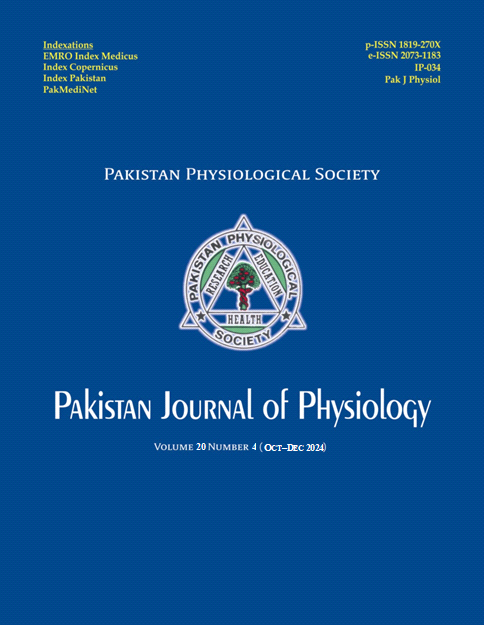GENDER DISPARITIES IN RISK OF METABOLIC SYNDROME AMONG OBESE YOUTH
DOI:
https://doi.org/10.69656/pjp.v20i4.1619Keywords:
Metabolic Syndrome, Obesity, Body Mass Index, BMIAbstract
Background: Metabolic syndrome in obese youth is linked to an increased risk of early disease onset, particularly in males. This study examined the relationship between obesity and the components of metabolic syndrome in youth. Methods: The study included subjects aged 19–21 from various colleges screened for obesity (BMI, WC, and WHtR). Blood samples were analysed for fasting blood sugar, triglycerides, HDL-C and insulin levels. Results: Obese males showed an insignificant 8% higher blood glucose level (5.468±0.12 mmol/L) than their corresponding controls (5.060±0.17 mmol/L), and a striking 14.5% difference between obese males and females (4.773±0.081 mmol/L) (p<0.001). Overweight and obese groups collectively demonstrated higher HDL-C levels compared to their controls, reflecting a general upward trend in young adults, though it was not significant. Insulin levels were higher in obese males (1.07±0.36 ?IU/mL) compared to their controls (0.411±0.089 ?IU/mL, but the differences were not significant. In overweight males, triglyceride levels (102.7±7.2 mg/dL) were 26% higher than normal-weight males (81.5±6.1 mg/dL) (p<0.05), while obese males showed a 36.2% elevation (111.3±6.8 mg/dL) (p<0.005) and significantly higher levels compared to obese females (89.9±5.9 mg/dL) (p<0.01). Conclusion: This study highlights the early development of metabolic disturbances in obese youth, with males being at higher risk for metabolic syndrome and related diseases.
Pak J Physiol 2024;20(4):37-9, DOI: https://doi.org/10.69656/pjp.v20i4.1619
Downloads
References
Alberti KG, Zimmet PZ. Definition, diagnosis and classification of diabetes mellitus and its complications. Part 1: Diagnosis and classification of diabetes mellitus provisional report of a WHO consultation. Diabetes Med 1998;15(7):539–53.
Sutkowska E, Sutkowski K, Soko?owski M, Franek E, Dragan S Sr. Distribution of the highest plantar pressure regions in patients with diabetes and its association with peripheral neuropathy, gender, age, and BMI: One centre study. J Diabetes Res 2019;2019:7395769.
Zou S, Yang C, Shen R, Wei X, Gong J, Pan Y, et al. Association between the Triglyceride-Glucose Index and the incidence of diabetes in people with different phenotypes of obesity: A retrospective study. Front Endocrinol (Lausanne) 2021;12:784616.
Flegal KM, Carroll MD, Ogden CL, Curtin LR. Prevalence and trends in obesity among US adults, 1999–2008. JAMA 2010;303(3):235–41.
Gortmaker SL, Must A, Sobol AM, Peterson K, Colditz GA, Dietz WH. Television viewing as a cause of increasing obesity among children in the United States, 1986–1990. Arch Pediatr Adolesc Med 1996;150(4):356–62.
Yensel CS, Preud’homme D, Curry DM. Childhood obesity and insulin-resistant syndrome. J Pediatr Nurs 2004;19:238–46.
Clemente-Suárez VJ, Martín-Rodríguez A, Redondo-Flórez L, López-Mora C, Yáñez-Sepúlveda R, Tornero-Aguilera JF. New insights and potential therapeutic interventions in metabolic diseases. In J Mol Sci 2023;24(13):10672.
Liu EQ, Weng YP, Zhou AM, Zeng CL. Association between Triglyceride-Glucose Index and Type 2 Diabetes Mellitus in the Japanese Population: A secondary analysis of a retrospective cohort study. Biomed Res Int 2020;2020:2947067.
Wang X, Liu J, Cheng Z, Zhong Y, Chen X, Song W. Triglyceride glucose-body mass index and the risk of diabetes: a general population-based cohort study. Lipids Health Dis 2021;20(1):99.
Dhondge RH, Agrawal S, Patil R, Kadu A, Kothari M. A comprehensive review of metabolic syndrome and its role in cardiovascular disease and type 2 diabetes mellitus: Mechanisms, risk factors, and management. Cureus 2024;16(8):e67428.
Fang X, Miao R, Wei J, Wu H, Tian J. Advances in multi-omics study of biomarkers of glycolipid metabolism disorder. Comput Struct Biotechnol J 2022;20:5935?51.
Ortega MA, Fraile-Martínez O, Naya I, García-Honduvilla N, Álvarez-Mon M, Buján J, et al. Type 2 diabetes mellitus associated with obesity (Diabesity). The central role of gut microbiota and its translational applications. Nutrients 2020;12(9):2749.
He K, Zhang W, Hu X, Zhao H, Song R, Bai K, et al. Stronger associations of body mass index and waist circumference with diabetes than waist-height ratio and triglyceride glucose index in the middle-aged and elderly population: A retrospective cohort study. J Diabetes Res 2022;2022:9982390.
Li S, Wang Y, Ying Y, Gong Q, Lou G, Liu Y, et al. Independent and joint associations of BMI and waist circumference with the onset of type 2 diabetes mellitus in Chinese adults: Prospective data linkage study. JMIR Public Health Surveill 2023;9:e39459.
Singh A, Hardin BI, Keyes D. Epidemiologic and etiologic considerations of obesity. In: StatPearls [Internet]. Treasure Island (FL): StatPearls Publishing; 2024.
Reaven G. Metabolic syndrome: pathophysiology and implications for management of cardiovascular disease. Circulation 2002;106(3):286–8.
Jayedi A, Soltani S, Zargar MS, Khan TA, Shab-Bidar S. Central fatness and risk of all cause mortality: systematic review and dose-response meta-analysis of 72 prospective cohort studies. BMJ 2020;370:m3324.
Zeng ZY, Liu SX, Xu H, Xu X, Liu XZ, Zhao XX. Association of triglyceride glucose index and its combination of obesity indices with prehypertension in lean individuals: A cross-sectional study of Chinese adults. J Clin Hypertens (Greenwich) 2020;22(6):1025–32.
Clayton TL, Fitch A, Bays HE. Obesity and hypertension: obesity medicine association (OMA) clinical practice statement (CPS) 2023. Obesity Pillars 2023;8:100083.
Dang K, Wang X, Hu J, Zhang Y, Cheng L, Qi X, et al. The association between triglyceride-glucose index and its combination with obesity indicators and cardiovascular disease: NHANES 2003–2018. Cardiovas Diabetol 2024;23(1):8.
Downloads
Published
How to Cite
Issue
Section
License

This work is licensed under a Creative Commons Attribution-NoDerivatives 4.0 International License.
The author(s) retain the copyrights and allow their publication in Pakistan Journal of Physiology, Pak J Physiol, PJP to be FREE for research and academic purposes. It can be downloaded and stored, printed, presented, projected, cited and quoted with full reference of, and acknowledgement to the author(s) and the PJP. The contents are published with an international CC-BY-ND-4.0 License.












